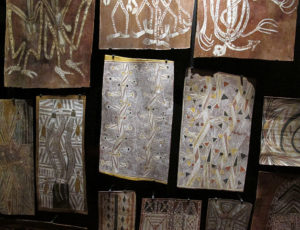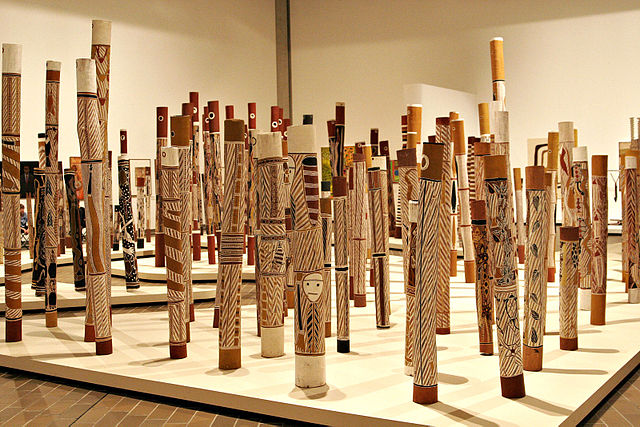The end of 2018 brought good news for collectors of Australian art. New regulations implemented under the Protection of Movable Cultural Heritage Act 1986 (PMCH 1986) will ease export restrictions on the Australian art trade, particularly for the works of indigenous artisans. The previous regulations have been in place with some amendments since 1987 and were due to sunset in April of 2019.

Aboriginal shields at the Ian Potter Centre: NGV Australia, Federation Square, Melbourne, Author: Travis from Sydney, NSW, Australia, Wikimedia Commons.
The December 6, 2018 amended regulations allow somewhat older artworks and more valuable artworks to be exported without an export permit being required. A schedule of the requirements (see below) gives age and value thresholds for different types of Aboriginal art and artifacts. Aboriginal art dealer D’Lan Davidson noted,
“This progressive legislation amendment will help support the unquestionable and renewed growth of international interest in Australian Indigenous art and its culture – and that’s great news for the industry, but more importantly, for the artists and communities that are reliant on its royalties.”
Davidson explained that because the previous regulations, dating to 1987, required export permits for artworks over 20 years of age and AUD $20,000 in value, foreign buyers, whether collectors or museums, were discouraged – not knowing if an export permit would be granted. Also, as time passed, more and more artworks made for sale by contemporary aboriginal artists came under the 1986 Act.
(Antiquated laws covering American Indian artworks and artifacts are similarly compromised by their age – the 1979 U.S. Archaeological Resources Protection Act applies to anything made by human hands over 100 years old. When passed, it applied primarily to non-commercial objects dating prior to 1879. Today, it covers objects from the several decades of commercial production before 1919.)
There are more restrictions on export of Pre‑1901 Aboriginal or Torres Strait Islander artworks and Pre‑1960 Aboriginal or Torres Strait Islander bark paintings or sculptures, both of which require an export permit if their value is over AUD $25,000 (the previous value limit was AUD $10,000).

20th C Aboriginal art displayed at the Musée du quai Branly, Paris, Author: Sailko from Wikimedia Commons
Aboriginal desert paintings (including pre‑1974 Aboriginal Papunya paintings) and Aboriginal Kimberley paintings on canvas will now require export permits only if valued over AUD $100,000. While the value thresholds for unrestricted export of these Aboriginal paintings are still far lower than non-Aboriginal oils and acrylics (threshold set at AUD $350,000) the amended regulations mark a step forward toward equal treatment with other Australian artworks.
The amended regulations mean that while the most important and valued objects will still receive greater scrutiny prior to export, more typical works can be freely traded.
As Davidson noted, when overly restrictive rules govern export, enthusiasm for the art as a whole wanes. The amendments are expected to be a boon not only for collectors, but also for indigenous artisans whose work may be sold and exported without hindrance.
While the 2018 regulations retain many provisions from the 1987 regulations, Part 5 – Objects of Fine or Decorative Art, has some significant changes, as follows:
Part 5—Objects of fine or decorative art
5.1 This Part lists objects of the category “Objects of fine or decorative art”.
5.2 An object is in this category if it is:
(a) an object of the kind mentioned in clause 5.3; or
(b) an object of the kind mentioned in clause 5.4 that:
(i) is an Australia‑related object; and
(ii) is at least 30 years old.
5.3 An object mentioned in column 1 of an item in the following table that has a current Australian market value of at least the amount mentioned in column 2 of the item is a Class A object.
| Objects of Fine or Decorative Art that are Class A objects | ||
| Item | Column 1
Object |
Column 2
Amount |
| 1 | Pre‑1901 Aboriginal or Torres Strait Islander artworks | $25,000 |
| 2 | Pre‑1960 Aboriginal or Torres Strait Islander bark paintings or sculptures not covered by item 1 of this table | $25,000 |
5.4 Objects in this category, other than objects mentioned in clause 5.3, are Class B objects and include an object mentioned in column 1 of an item in the following table that has a current Australian market value of at least the amount mentioned in column 2 of the item.
| Objects of Fine or Decorative Art that are Class B objects | ||
| Item | Column 1
Object |
Column 2
Amount |
| 1 | Watercolours, pastels, drawings, sketches and other similar works | $40,000 |
| 2 | Aboriginal desert paintings (including pre‑1974 Aboriginal Papunya paintings), other than a painting that is a Class A object because of paragraph 1.3(a) of this Schedule
[ed. note: 1.3(a) covers sacred and secret ritual objects, see below] |
$100,000 |
| 3 | Aboriginal Kimberley paintings on canvas | $100,000 |
| 4 | Oil and acrylic paintings not covered by item 1, 2 or 3 of this table | $350,000 |
| 5 | Aboriginal or Torres Strait Islander ochre paintings that are on bark, composition board, wood, cardboard, stone or other similar supports | $20,000 |
| 6 | Prints, posters, photographs and similar works of art with potential for multiple production | $10,000 |
| 7 | Textiles, including tapestries, carpets and batiks | $10,000 |
| 8 | Sculptures | $30,000 |
| 9 | Furniture | $30,000 |
| 10 | Jewellery | $40,000 |
| 11 | Clocks and watches | $40,000 |
| 12 | Musical instruments | $10,000 |
| 13 | Architectural fittings and decoration and interior decoration | $15,000 |
| 14 | Objects made from precious metals | $25,000 |
| 15 | Any objects of fine or decorative art that are not covered by another item of this table | $10,000 |
5.5 However, an object is not in this category if it is owned by the person who created the object.
Note that in the 2018 regulations:
1.3 The following objects of this category are Class A objects:
(a) sacred and secret ritual objects;
(b) bark and log coffins used as traditional burial objects;
(c) human remains;
(d) rock art;
(e) dendroglyphs.
See the full text of the Protection of Movable Cultural Heritage Regulations 2018.
 Aboriginal hollow log tombs - National Gallery Canberra, Author: Fir0002/Flagstaffotos, Wikimedia Commons
Aboriginal hollow log tombs - National Gallery Canberra, Author: Fir0002/Flagstaffotos, Wikimedia Commons 

